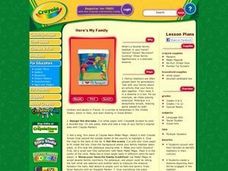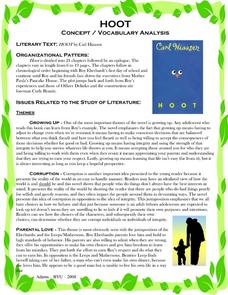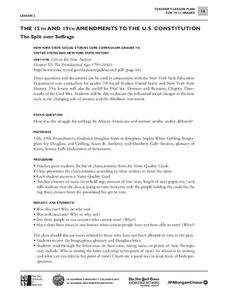Penguin Books
A Teacher's Guide to the Signet Classics Edition of Romeo and Juliet by William Shakespeare
A 24-page teacher's guide to Romeo and Juliet includes scene-by-scene plot summaries, focus, discussion questions, and suggestions for individual and group projects.
Curated OER
Here's My Family
Family traditions help to instill personal values, social norms, and the warmest of childhood memories. Elementary and secondary learners share their favorite family traditions with a fun diorama project. Using modeling clay, they create...
Curated OER
The Physics of Sports: An 8th Grade Physical Science Project
Explore the relationship between sports and physics in a cross-curricular lesson. Middle and high schoolers prepare a multimedia presentation based on a chosen sport. They answer five physics vocabulary questions about how the laws of...
Curated OER
Making Active, Healthy Lifestyle Choices
Making wise lifestyle choices means making decisions that will positively impact overall health. Help young learners identify active, healthy choices with a collage project in which they cut out pictures from magazines depicting healthy...
National Gallery of Canada
Morphosis
Experience anthropomorphism and metamorphosis in action with flipbooks! Instead of giving human characteristics to animals, though, pupils will show a transformation from human to animal or vise versa through their drawings. The...
CCW Resources
Cursive Outline Alphabet
Perfect for decorating your classroom or language arts center, this set of cursive alphabet letters can show learners the twist, turns, and loops they'll need to writing in cursive. Each page includes one letter with a black outline and...
Inspired By Kindergarten
Numbers 1-10
Preschoolers and kindergartners can master numbers 1-10 with a set of math worksheets. Each page features one number that kids trace, represent with tally marks, and write what number they will have after adding or subtracting 1.
Curated OER
Hoot: Concept/Vocabulary Analysis
Augment your unit on Carl Hiaasen's Hoot with a series of activities about the environment, civil disobedience, making an impact in the world, and growing up. A list of literary concepts and themes helps you to write your lessons to...
EngageNY
Grade 9 ELA Module 1, Unit 1, Lesson 6
Can you tell everything about a character based on their actions? Delve into the prominent characters of Karen Russell's "St. Lucy's Home for Girls Raised by Wolves" with helpful reading tips and discussion questions. A thorough lesson...
EngageNY
Grade 9 ELA Module 1, Unit 1, Lesson 15
How much progress has Claudette made at the end of "St. Lucy's Home for Girls Raised by Wolves"? Ninth graders note evidence for and against Claudette's successful adaptation into human society with a graphic organizer. Additionally,...
Curated OER
Volcanoes: First Grade Lesson Plans and Activities
Introduce young geologists to types of volcanoes during the pre-lab. First graders explore how different liquids flow with an experiment on viscosity to simulate how different types of lava flow. Next, they learn...
K12 Reader
Narrator’s Point of View Flow Chart
How can you tell what point of view a narrator is using, and why does it matter when reading or writing? Use a handy flow chart to determine whether or not your narrator is telling the story from a first or third person point of view.
Teacher's Corner
Dr. Seuss Book Report - Character
Bring the imaginative spark in every Dr. Seuss book to your reading lesson with a book report worksheet. After they read the story, learners write a short summary of the tale and include an illustration of their favorite character.
EngageNY
Grade 9 ELA Module 3, Unit 2, Lesson 7
Now that learners have honed their inquiry-based projects down to their strongest few questions, they can conduct independent research. High schoolers pursue answers to their inquiries while assessing sources, establishing a research...
Curated OER
Genome: The Secret of How Life Works
What do you have in common with a fruit fly? About 60 percent of your DNA. The resource, divided into two units, is intended for grades four to eight and another for high schoolers. Both units include eight lessons covering the...
City University of New York
The 15th and 19th Amendments to the U.S. Constitution
Who gets to vote? Learn more about struggles for suffrage throughout United States history with a lesson plan based on primary source documents. Middle schoolers debate the importance of women's suffrage and African American...
Other popular searches
- Biography Writing Project
- Holiday Writing Project
- Book Writing Project
- Writing Project
- Research Writing Project
- Business Writing Project
- Interactive Writing Project
- Comic Book Writing Project
- Process Writing Project
- Multi Age Writing Project
- Creative Writing Project
- Revising Project Plan

















